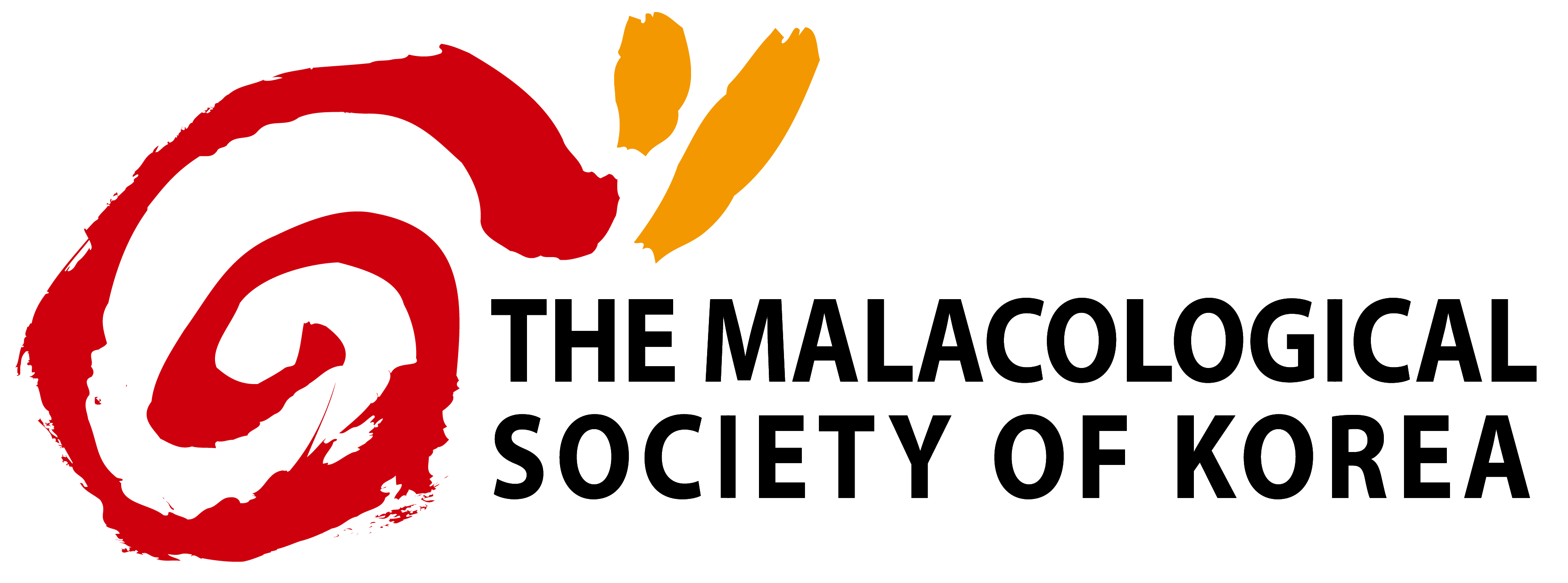open access
메뉴
open access
메뉴 ISSN : 1225-3480
ISSN : 1225-3480
충청남도 서천군 비인만 앞바다 조간대에서 채집된 큰구슬우렁이, Glossaulax didyma를 대상으로 생식소발달단계에 따른 생식주기, 난괴 내의 난낭, 그리고 군성숙도와 성비 등을 조직학적 관찰과 형태측정 자료에 의해 조사하였다. 생식소중량지수 (GSI) 암, 수의 월별 변화는 암컷의 경우, 2월부터 증가하기 시작하여 5월에 최대값을 이룬 후, 6월부터 8월까지 감소하였다. 수컷의 경우도 5월에 최고값을 나타낸 후, 6월부터 8월까지 감소하여 암컷과 유사한 경향을 보였다. 따라서 암, 수 개체의 산란기는 5월 하순-8월로 추정되었다. 비만도지수 (CI) 의 월별 변화는 암컷의 경우, 2월부터 4월까지 서서히 증가하기 시작하여 5월에 최대값을 나타낸 후, 6월부터 8월까지 감소하였다. 그리고 9월부터 12월까지 다시 증가하는 경향을 보였다. 수컷의 경우도 암컷과 같이 2월에 서서히 증가하기 시작하여 5월에 최고값을 나타낸 후, 6-8월까지 감소하였다. 따라서 비만도지수에 의해 산란기를 판정하여 볼 때, 5월 하순-8월로 추정되었다. 산란기는 암컷의 경우, 5월 하순-8월 말 사이이었고, 수컷은 5월 초-8월 말까지 이었으며, 주산란은 수온이 19℃ 이상인 7-8월에 일어났다. 생식주기는 암컷의 경우, 초기활성기 (12-2월), 후기활성기 (2-3월), 완숙기 (4-7월), 산란기 (5월 하순-8월), 회복기 (8-11월)의 연속적인 5단계로 구분되었고, 수컷의 경우는 활성기 (12-3월), 완숙기 (3-7월), 교미기 (5월 초-8월), 회복기 (8-1월) 의 연속적인 4단계로 구분되었다. 완숙난모세포의 크기는 직경이 250-270 μm이었다. 난괴는 모자 모양이었고, 한 개의 난괴 속에서 수많은 난낭 (0.53-0.57 mm) 들이 발견되었다. 한 개의 난낭에서 한 개의 배 (veliger 유생) 가 부화되었다. 큰구슬우렁이의 군성숙도는 각경 40.1-45.0 mm인 암, 수 개체 모두 군성숙도(%) 50% 이상이었고, 각경 45.1 mm 이상의 개체는 군성숙도가 100%였다. 암, 수의 성비는 1:1이 아닌 것으로 확인되었다 (χ2 = 57.22, p < 0.05).
The reproductive cycle, egg capsules in the egg-mass, first sexual maturity, and sex ratio of the bladder moon, Glossaulax didyma (Rding) were investigated. The gastropods collected from the intertidal zone of Biin Bay, Seocheon, Korea were studied by using histological analysis and morphometric data. The gonadosomatic index (GSI) of females and males began to increase in March and reached maximum in May. Then their values sharply decreased from late in May to August due to spawning. The condition index (CI) began to increase in February and reached maximum in May, then gradually declined in the spawning period. The CI calculated for determination of the spawning period was coincided with changes in the GSI and gonadal phases. Spawning occurred between late in May to August in females and early in May to August in males. Spawning peak was observed between July and August when the seawater temperature rose to 19 ℃. Reproductive cycle with the gonadal development phases of this species can be divided into five successive stages in females and four in males: in females, early active stage (December to February), late active stage (February to March), ripe stage (April to July), spawning stage (late May to August), and recovery stage (August to November); in males, active stage (December to March), ripe stage (March to July), copulation stage (early May to August), and recovery stage (August to January). Fully matured oocytes were approximately 250-270 μm in size. The egg-mass was a hat in shape, and a number of egg capsules were found in an egg-mass. An egg capsule was 0.53-0.57 mm in size. An embryo (veliger larva) hatched from an egg capsule. Percentage of first sexual maturity in females and males were over 50% for individuals that are 40.1-45.0 mm in shell radius, and 100% for those that are over 45.1 mm. The sex ratio of female to male was significantly different from 1:1 (χ2 = 57.22, p < 0.05).
M, (1963) A comparative embryology of marine gastropods with ecological considerations. Bulletin of Shimonoseki University of Fisheries,
R.A, (1962183-192.) On the reproductive cycle and breeding habits of two western species of Haliotis. Biological Bulletin,
Chung, (1993) with special reference to the reproductive cycle depositions of egg capsules and hatchings of larvae. Korean Journal of Malacology,
Chung, (1991) Sexual maturation of the venus clam on the west coast of Korea. Journal of Medical and Applied Malacology,
Chung E.Y, (1994) age and growth of the shortnecked clam on the coast of Kimje Korea. Korean Journal of Malacology,
Chung, E.Y, (2001) Gonadal development and the reproductive cycle of the bladder moon, Glossaulax didyma (Mesogastropoda: Naticidae), on the west coast of Korea,
V, (1984) ed. by Tompa, N.H.. and van den Biggelaar pp. 1-45. Academic Press
Griffiths, (1977) Reproductive cycles in littoral populations of Chloromytilus meridionalis with a quantitative assessment of gamete production in the former. Journal of Experiment Marine Biology and Ecology,
T, (1969) A nomenclatorial note on Glossaulax didyma,
Higo, S.I, (1999) Catalogue and Bibliography of the Marine Shell-bearing Mollusca of Japan, Elle Scientific Publications
Kim, J.Y, (1999) Seasonal variation of the primary productivity in the vicinity of Chulpo Sea area, Kunsan National University
Kim, (1977) Studies on the growth of hard clam . Bulletin of Fisheries Research and Development Agency,
Kwon, (1993) Coloured Shells of Korea. 285 pp. Academy Publishing Co.,
Kwon, O.K, (2001) Korean Molluscs with Color Illustration, Min Shell House, Seoul
Lee, (1995) Growth and maturation of shortnecked clams, Ruditapes philippinarum by different seeding production areas,
Lee, (1985) Heated sterilization condition for canned Neverita didyma. Bulletin of Fishery Science Institute,
Lee, (1984) Changes in quality of boiled Neverita didyma as a function of autoclaving conditions. Journal of Korean Society Food Nutrition,
K, (1976) Studies on the reproduction of a scallop - 1. Reproductive cycle of the cultured scallop. Science Reports Hokkaido Fishery Experiment Station,
Yoo, (1976) Korean Shells in Colour. 196 pp. Ilgisa,
